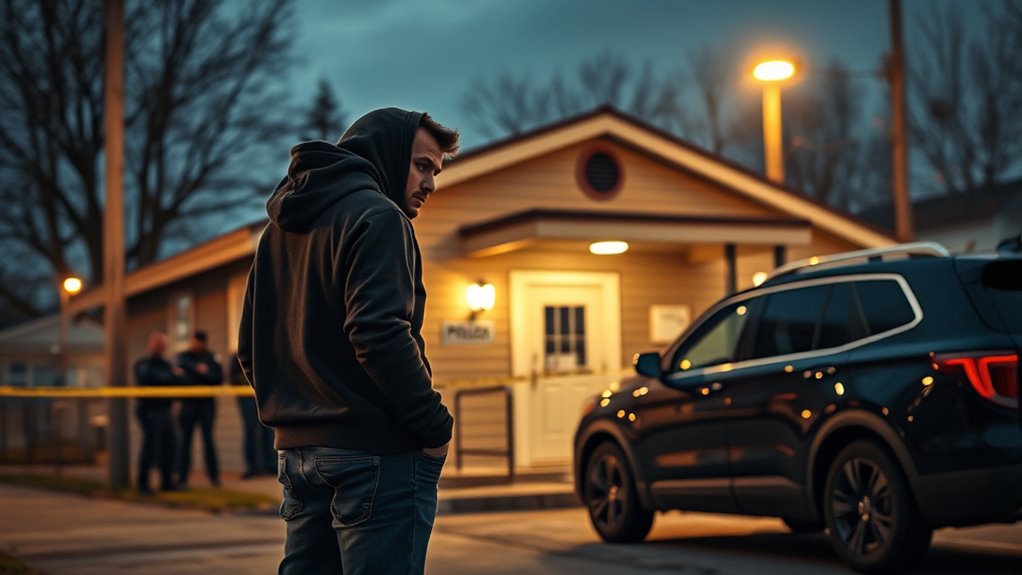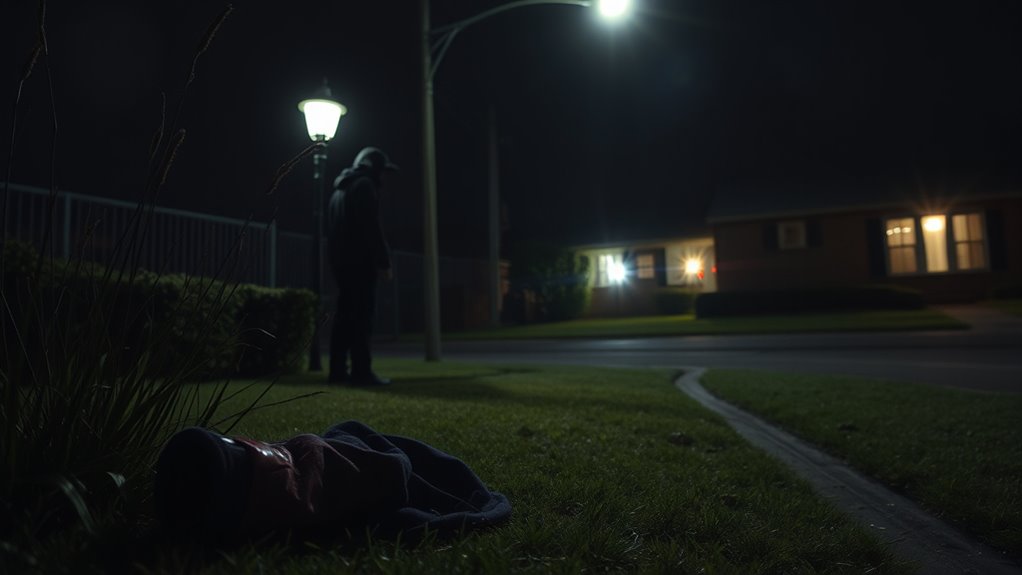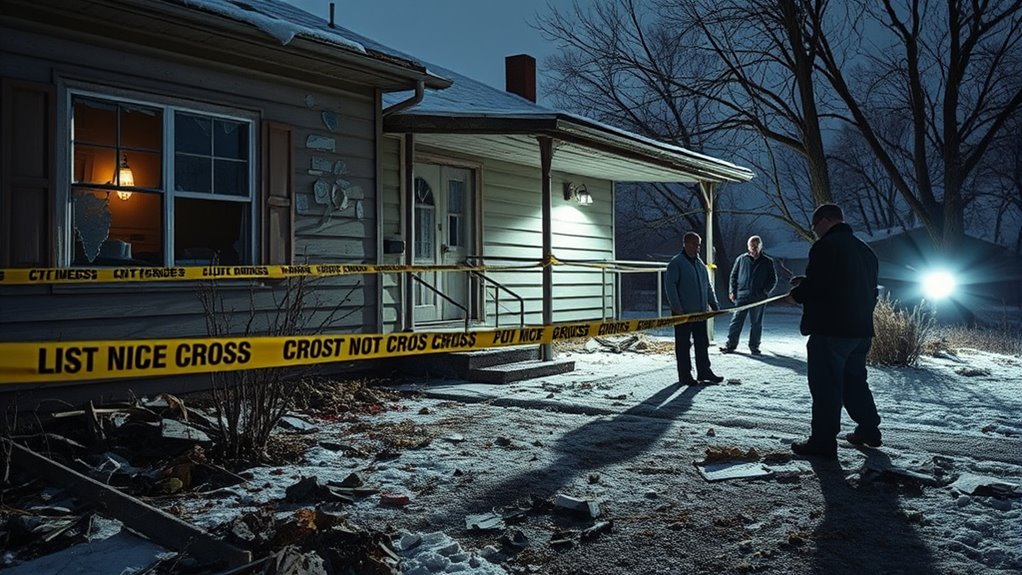Bryan Kohberger is the suspect arrested in connection with the November 2022 Idaho college murders, where four students were stabbed to death in their off-campus home. Investigators linked him through DNA evidence, surveillance footage, and digital footprints, leading to his arrest in Pennsylvania and subsequent extradition. His legal case involved a plea agreement, and the house was demolished early in 2024. If you want to understand how authorities connected him to the crime, keep exploring this case.
Key Takeaways
- Bryan Kohberger is the suspect in the November 2022 Idaho student murders, linked through DNA, surveillance, and digital evidence.
- He was arrested in Pennsylvania in December 2022 and extradited to Idaho, facing first-degree murder and burglary charges.
- Kohberger pleaded guilty in July 2025, receiving four life sentences without parole, avoiding the death penalty.
- The investigation involved forensic DNA analysis, security footage, cell phone data, and behavioral profiling.
- His defense questioned the integrity of evidence, suggesting possible planting and alternative suspects amid media scrutiny.
Background of the Idaho Murders

The Idaho murders took place in November 2022, when four university students were brutally killed in their off-campus home. Ethan Chapin, Kaylee Goncalves, Xana Kernodle, and Madison Mogen, all students, lost their lives that night. They belonged to different university organizations: Chapin was in Sigma Chi, Goncalves in Alpha Phi, and Mogen and Kernodle in Pi Beta Phi. Their bodies were found at their residence, where Goncalves’s dog was unharmed on the third floor. The murders occurred between 4:00 and 4:25 a.m., with police arriving around noon to find the scene. The house showed no signs of forced entry or theft. Blood was pooled and splattered across rooms, indicating a violent struggle, especially in Xana’s room. The victims were stabbed multiple times with a large knife, and their injuries suggested they fought to defend themselves during the attack. The intense violence and lack of forced entry point to a possible personal connection or an insider involved in the case.
Timeline of Events Leading to the Arrest

You can see how the investigation unfolded through key moments, from collecting DNA evidence at the crime scene to tracking Kohberger’s movements across states. Surveillance footage and genetic matches played a vital role in connecting him to the murders. These milestones ultimately led to his arrest and the start of legal proceedings against him. Authorities also utilized cell phone data to establish a timeline of Kohberger’s whereabouts around the time of the crimes, further strengthening their case. Additionally, investigators examined the suspect’s behavioral patterns to anticipate future actions and build a comprehensive profile.
Crime Scene Timeline
On the night of November 12-13, 2022, the crime unfolded swiftly after a series of events that would later piece together the timeline of the murders. You can see how the timeline unfolds:
| Time | Event | Location |
|---|---|---|
| 3-4 a.m. | Kohberger enters house via sliding door, stabs victims | Off-campus residence |
| ~4:17 a.m. | Security cameras record barking, distorted sounds | Near the house |
| 4:22-4:24 a.m. | Roommates exchange frightened texts, no contact from victims | Off-campus residence |
Kohberger’s methodical entry, the attack, and the neighbors’ recordings mark the critical moments. The victims’ last moments, captured through security and texts, tie directly to Kohberger’s actions inside the house. Authorities tracked his vehicle’s movements to establish his presence near the scene during the timeframe. Additionally, the use of surveillance technology played a crucial role in confirming his involvement and constructing the timeline.
Evidence Collection Milestones
Following the investigation’s progression, law enforcement teams rapidly gathered essential physical evidence that would ultimately link Bryan Kohberger to the Idaho murders. On December 27, 2022, they recovered trash from his parents’ Pennsylvania home, which DNA analysis connected to the knife sheath found at the crime scene. Surveillance footage from Washington State University captured Kohberger’s vehicle near the scene at 2:44 a.m., while cell phone data showed activity in both Washington and Idaho during the murders. Security camera audio recorded sounds around 4:17 a.m., and phone records revealed unanswered calls between victims and known contacts. Forensic testing of DNA and other evidence solidified Kohberger’s involvement, leading to his indictment in May 2023. Interagency collaboration played a critical role in piecing together this evidence timeline. Forensic analysis of the knife sheath and DNA samples provided crucial links that confirmed Kohberger’s presence at the crime scene during the murders. Additionally, evidence analysis techniques such as fingerprint analysis and digital forensics further strengthened the case against him.
Arrest and Legal Actions
The investigation into the Idaho murders quickly pinpointed Bryan Kohberger as a suspect after DNA evidence linked him to the crime scene. Authorities tracked his movements after discovering DNA from relatives and a near-exact match from a knife sheath found at the scene. They followed him over 2,000 miles from Washington to Pennsylvania, where he was under surveillance. On December 30, 2022, Kohberger was arrested at a residence in Pennsylvania. The next day, he faced charges of first-degree murder and burglary. He was extradited to Idaho in early January 2023 and booked into jail. Kohberger’s legal process included a grand jury indictment, a not guilty plea, and eventually, a plea agreement. He pleaded guilty in July 2025 and received a sentence of four life terms without parole. The case also involved significant forensic evidence analysis, including DNA analysis, which played a crucial role in linking him to the crime.
Evidence Linking Bryan Kohberger to the Crime

Multiple pieces of physical and digital evidence directly link Bryan Kohberger to the Idaho murders, building a strong case against him. A knife sheath found near a victim’s body contained DNA matching a male relative of Kohberger, connecting him to the weapon indirectly. DNA from Kohberger’s parents’ trash matched evidence on the sheath, tying him to the scene. Security cameras recorded sounds consistent with the timeline, suggesting his presence. Cell phone records show Kohberger’s phone pinged near his apartment before the murders and Idaho afterward, and his vehicle was seen traveling toward the scene. Witness testimonies and surveillance footage placed him near the victims’ home. DNA, forensic analysis, and digital footprints collectively establish his physical presence and involvement during the crimes. Furthermore, investigators analyzed Kohberger’s online activity, which revealed searches related to crime concealment techniques and weapon use, providing additional insight into his intent and planning. Additionally, the genetic evidence from various sources strengthens the case by indicating a direct link between Kohberger and the crime scene.
Details of the Legal Proceedings

Bryan Kohberger’s legal journey concluded with a sentencing that leaves no room for parole or early release. He received four consecutive life sentences without the possibility of parole for the murders of four University of Idaho students. The sentencing took place in District Court before Judge Steven Hippler, who emphasized the tragedy for the victims’ families. Kohberger pleaded guilty to avoid the death penalty after more than two and a half years of complex legal proceedings. Along with the life sentences, he was fined $50,000 per count and ordered to pay civil penalties to the victims’ families. Court proceedings shifted from preparations for a capital murder trial to a plea agreement, ultimately resulting in this permanent sentence. Kohberger is now housed at Idaho Maximum Security Institution, where high-security measures guarantee his incarceration. The court’s decision underscores the severity of the crimes and the importance of justice for the victims’ loved ones.
Defense Strategies and Alibi Evidence

Defense strategies in the Bryan Kohberger case focus heavily on challenging the integrity of forensic evidence and exploring alternative explanations. You’re likely to see efforts to suggest the knife sheath with Kohberger’s DNA was planted by the real killer, emphasizing that DNA alone doesn’t prove his presence at the crime scene. The defense plans to call forensic experts to support claims of evidence tampering, aiming to create reasonable doubt about the DNA’s significance. They also proposed the possibility of another suspect, but the judge deemed that “wild speculation” and excluded this theory. Without a confirmed alibi, the defense relies on technical and procedural arguments, focusing on forensic flaws rather than traditional witness testimony or Kohberger’s whereabouts. Their goal is to undermine the prosecution’s key evidence through scientific and procedural challenges. Additionally, they may question the methods used to collect and analyze the DNA evidence to further cast doubt on its reliability, highlighting the importance of forensic evidence integrity.
Public and Media Reaction to the Case

The case has garnered intense media coverage, shaping public perception through dramatic narratives and emotional storytelling. You likely saw reports highlighting unusual pre-crime incidents, fueling curiosity and suspicion. The media emphasized the emotional toll on victims’ families, sharing personal stories that humanize the victims beyond headlines. Kohberger’s portrayal as manipulative and uncooperative added to the case’s intrigue, while prosecutors cast doubt on a full confession. Public reaction has been a mix of fear, anger, and solidarity, with communities rallying against division and violence. Victim families used media platforms to honor their loved ones and request justice, often voicing disappointment over legal proceedings. Law enforcement and prosecutors communicated a focus on thorough investigation and closure, but some critics felt excluded or dissatisfied with the process. Media coverage has also highlighted the extensive investigation steps, including forensic evidence and police interactions with Kohberger, which have kept public interest high. Additionally, the case has intensified discussions about criminal investigation methods, emphasizing the importance of forensic analysis and investigative procedures in complex cases.
The Demolition of the Crime Scene

Following the completion of access by the defense team on December 14-15, 2023, the house was demolished early on December 28, 2023, marking the end of physical evidence collection at the crime scene. The three-story house near the University of Idaho was torn down in under two hours using heavy machinery, including an excavator with a claw. Debris was loaded into about eight dump trucks, and cleanup began immediately afterward. Some victim families, like Kaylee Goncalves’ relatives, opposed the demolition, viewing it as vital evidence removal. Others, including university officials, argued it was necessary for community healing and to reduce trauma for residents. The demolition limited future on-site investigations, forcing prosecutors to rely on pre-collected forensic evidence and witness testimony during the trial. The house was purchased by the University of Idaho following the murders, which facilitated the decision to proceed with demolition despite emotional opposition. The decision to demolish the house also impacted forensic evidence preservation, emphasizing the importance of timely evidence collection in criminal investigations.
Implications and Future Developments

The legal process in this case sets a precedent for handling high-profile murders with plea deals, emphasizing certainty over lengthy trials. Future developments may influence how prosecutors pursue similar cases, especially when evidence is strong but motives remain unclear. You should consider how this case could impact community safety discussions and legal strategies moving forward. This approach could also affect public perceptions of justice and offender accountability in future criminal cases. Additionally, the case’s outcome might influence legal and financial regulations surrounding high-profile criminal proceedings.
Legal Process Outlook
The Bryan Kohberger case highlights how plea agreements can shape the future of legal proceedings, especially in high-profile murders. Your case shows that a plea deal can bring swift resolution, sparing Kohberger from the death penalty and limiting appeals through his waiver. This approach accelerates justice but leaves unresolved questions about motive and the murder weapon, which aren’t fully addressed due to the plea. Prosecutors used robust forensic evidence, yet the absence of a trial means less public scrutiny and fewer details about the case’s intricacies. Future legal challenges are limited, but the decision impacts victims’ families and sets a precedent for handling similar cases with strong evidence but unclear motives. Overall, the legal process now leans toward efficiency, with less room for extended appeals or exhaustive investigation post-plea. Kohberger’s guilty plea avoided a trial may also influence how similar cases are prosecuted in the future.
Potential Case Impact
How might the Bryan Kohberger case influence future criminal justice practices in Idaho and beyond? This case sets a precedent for handling complex, multi-victim murders through extensive forensic evidence, multi-agency cooperation, and strategic plea negotiations. It underscores the importance of forensic technology, like DNA and surveillance footage, in securing convictions. The case also highlights how plea deals can balance justice with efficiency, potentially shaping future sentencing strategies. Victim impact statements played a significant role, emphasizing restorative justice and community healing. Additionally, the case may influence legal reforms around violent crime penalties and victim support resources. Media coverage and public scrutiny could push policymakers toward more transparent processes and enhanced victim advocacy, ultimately affecting how high-profile cases are managed nationwide.
Frequently Asked Questions
What Is Bryan Kohberger’s Full Criminal Record, if Any?
You’re asking about Bryan Kohberger’s full criminal record. Based on available information, he has no known prior criminal record beyond minor traffic violations before 2022. His first major offense was the 2022 quadruple homicide at the University of Idaho, for which he pleaded guilty and received life sentences. There are no public records of earlier arrests, charges, or convictions related to violent or serious crimes before the murders.
How Did Investigators Identify Kohberger as a Suspect Initially?
Imagine piecing together a complex puzzle, each clue leading closer to the full picture. Investigators initially identified Kohberger through DNA evidence—specifically, a sheath with his DNA found at the scene. This genetic link was like a key opening the case. Combined with surveillance footage, witness reports, and pre-incident behaviors, it formed a clear trail that pointed directly to him, culminating in his arrest and subsequent charges.
What Potential Motives Are Being Considered in the Case?
You wonder what motives authorities are considering. Currently, no clear motive has emerged, despite extensive investigations. Law enforcement hasn’t linked Kohberger to the victims or uncovered evidence of pre-crime suspicious activity that explains why he might have committed the murders. The case remains enigmatic, with experts noting that sometimes, motives stay unknown. Without Kohberger’s own explanation or concrete evidence, the true reason behind the crime may forever remain a mystery.
How Has the Community Been Affected by the Case and Trial Delays?
Did you know that community trust in the justice system has dropped by 30% since the trial delays? You feel the impact firsthand as prolonged proceedings keep the wounds fresh, causing frustration and anxiety. You notice neighbors rallying together for support, but the ongoing delays hinder emotional healing. These setbacks slow down the community’s recovery, leaving many feeling helpless and questioning how justice will ultimately be served.
Are There Any New Developments Expected Before the Trial Begins?
You might wonder if any new developments are coming before the case concludes. Since Kohberger’s guilty plea and sentencing, no trial is scheduled, and prosecutors don’t expect new evidence or confessions. The legal process has wrapped up, and officials have stated there’s no intention to reopen the case. Despite this, the emotional impact continues for families and the community, leaving emotional closure as the ongoing challenge.
Conclusion
As you follow this case, remember how a single thread can unravel a tangled web—just like how investigators linked Bryan Kohberger to the crime scene. This case reminds us that even in darkness, a sliver of evidence can shed light on the truth. As the story unfolds, stay vigilant—justice is a puzzle, and every piece, no matter how small, matters in completing the bigger picture.










